1. Consider the following statements regarding vaccine-derived poliovirus (VDPV) seen in news recently.
- It is primarily caused by Injectable inactivated polio vaccine.
- Generally oral poliovirus vaccines contains a live, weakened form of poliovirus that replicates in the intestine to decrease cases related to vaccine-derived poliovirus (VDPV)
- VDPVs can cause outbreaks in places where vaccine coverage is low.
Which of the statements given above/are correct?
A. 1 and 2 only
B. 2 and 3 only
C. 3 only
D. All of the above.
2. Consider the following statements regarding Lumpy skin disease seen in news recently:
- It is an infectious disease in cattle caused by bacteria
- The disease is zoonotic, meaning it spread from animals to humans
- It is not safe to consume milk from the infected animal.
Which of the statements given above /are incorrect :
A. 1 and 2 only
B. 2 and 3 only
C. 1 and 3 only
D. All of the above.
3. Recently Ramsay Hunt Syndrome seen in news related to
A. Decrease in bone density
B. Inflammation of nerves
C. Lungs infection
D. Hypervitaminosis
4. Consider the following statements in context to West Nile virus (WNV) and Malaria:
- Anopheles mosquito transmits malaria to humans, Culex mosquitoes transmit the West Nile virus.
- Both diseases are caused by a parasite called plasmodium
- Malaria has a specific line of treatment and can be cured but there is no specific treatment for West Nile virus
Select the correct answer code:
A. 1 only
B. 1 and 2 only
C. 1 and 3 only
D. 2 and 3 only
5. Consider the following statements:
- Glucagon increases blood sugar levels, whereas insulin decreases blood sugar levels
- Pancreas releases both Glucagon as well as insulin.
- Body produces no or little insulin in type I Diabetes
- In type II Diabetes body unable to utilize insulin properly
Select the correct answer code:
A. 1, 2 and 3 only
B. 2, 3 and 4 only
C. 1, 3 and 4 only
D. All of the above.
Answers with Explanation
1. Consider the following statements regarding vaccine-derived poliovirus (VDPV) seen in news recently.
- It is primarily caused by Injectable inactivated polio vaccine.
- Generally oral poliovirus vaccines contains a live, weakened form of poliovirus that replicates in the intestine to decrease cases related to vaccine-derived poliovirus (VDPV)
- VDPVs can cause outbreaks in places where vaccine coverage is low.
Which of the statements given above/are correct?
A. 1 and 2 only
B. 2 and 3 only
C. 3 only
D. All of the above.
Answer: C
Explanation
What is vaccine-derived polio?
- Oral polio vaccine (OPV) contains an attenuated (weakened) vaccine-virus, activating an immune response in the body. When a child is immunized with OPV, the weakened vaccine-virus replicates in the intestine for a limited period, thereby developing immunity by building up antibodies. During this time, the vaccine-virus is also excreted. In areas of inadequate sanitation, this excreted vaccine-virus can spread in the immediate community (and this can offer protection to other children through ‘passive’ immunization), before eventually dying out
- On rare occasions, if a population is seriously under-immunized, an excreted vaccine-virus can continue to circulate for an extended period of time. The longer it is allowed to survive, the more genetic changes it undergoes. In very rare instances, the vaccine-virus can genetically change into a form that can paralyse – this is what is known as a circulating vaccine-derived poliovirus (cVDPV).
- the problem is not with the vaccine itself, but low vaccination coverage. If a population is fully immunized, they will be protected against both vaccine-derived and wild polioviruses.
2. Consider the following statements regarding Lumpy skin disease seen in news recently:
- It is an infectious disease in cattle caused by bacteria
- The disease is zoonotic, meaning it spread from animals to humans
- It is not safe to consume milk from the infected animal.
Which of the statements given above /are incorrect :
A. 1 and 2 only
B. 2 and 3 only
C. 1 and 3 only
D. All of the above
Answer: D
Explanation
Lumpy skin disease
- Some 1,229 cattle across five districts of Gujarat have been infected with Lumpy Skin Disease (LSD), an infectious viral disease, in the past one month.
- It is caused by infection of cattle or buffalo with the poxvirus Lumpy skin disease virus (LSDV).
- Historically, LSD has remained confined to Africa, where it was first discovered in 1929, and parts of West Asia.
- LSD was first reported in Asia and the Pacific region in 2019 in north west China, Bangladesh and India.
Symptoms:
- It appears as nodules of two to five-centimetre diameter all over the body, particularly around the head, neck, limbs, udder and genitals.
- The lumps gradually open up like large and deep wounds.
Transmission:
- The LSD virus easily spreads by blood-sucking insects like mosquitoes, flies and ticks and through saliva and contaminated water and food.
Treatment:
- There are no specific antiviral drugs available for the treatment of lumpy skin disease.
- Vaccines are the only cure to an LSD epidemic.
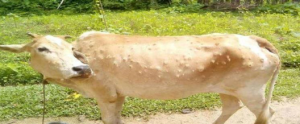
3. Recently Ramsay Hunt Syndrome seen in news related to
A. Decrease in bone density
B. Inflammation of nerves
C. Lungs infection
D. Hypervitaminosis
Answer: B
Explanation
Ramsay Hunt Syndrome
- Recently, Pop sensation Justin Bieber revealed that a viral disease has temporarily paralysed one side of his face.
- Bieber said he has developed a rare condition called the Ramsay Hunt Syndrome
Ramsay Hunt Syndrome
- Ramsay Hunt Syndrome is neurological disease in which a virus – Varicella Zoster – causes inflammation of the nerves involved in facial movements.
- When the nerves get inflamed, they lose their ability to function, leading to temporary facial palsy or paralysis. What it means is that facial muscles in the infected person cannot receive necessary signals to function properly.
- There are 12 cranial nerves in the body. Ramsay Hunt Syndrome is the viral infection impacting the 7th cranial nerve that is involved in facial movements. The inflammation caused by the Varicella Zoster Virus makes the nerve ineffective.
4. Consider the following statements in context to West Nile virus (WNV) and Malaria:
- Anopheles mosquito transmits malaria to humans, Culex mosquitoes transmit the West Nile virus.
- Both diseases are caused by a parasite called plasmodium
- Malaria has a specific line of treatment and can be cured but there is no specific treatment for West Nile virus
Select the correct answer code:
A. 1 only
B. 1 and 2 only
C. 1 and 3 only
D. 2 and 3 only
Answer: C
Explanation
West Nile virus Vs malaria?
- The similarities are that they are both mosquito-borne diseases and sometimes, both can be potentially life-threatening.
- However, malaria is caused by a parasite called plasmodium, and the West Nile virus is a single-stranded RNA virus that causes West Nile fever.
- Also, while the female Anopheles mosquito transmits malaria to humans, Culex mosquitoes transmit the West Nile virus.
- Additionally, malaria presents symptoms like fever with chills and, an immediately throbbing headache with chances of complications being high. But the symptoms of West Nile virus do not always immediately become evident.
- Treatment wise, malaria has a specific line of treatment and can be cured. There is no specific treatment for West Nile virus because it is a viral disease. As reported, many people do not even realise they have been infected.
5. Consider the following statements:
- Glucagon increases blood sugar levels, whereas insulin decreases blood sugar levels
- Pancreas releases both Glucagon as well as insulin.
- Body produces no or little insulin in type I Diabetes
- In type II Diabetes body unable to utilize insulin properly
Select the correct answer code:
A. 1, 2 and 3 only
B. 2, 3 and 4 only
C. 1, 3 and 4 only
D. All of the above.
Answer: D
Explanation
Diabetes
- Recently Indian Council of Medical Research (IMCR) released guidelines for the diagnosis, treatment, and management for type-1 diabetes.
- This is the first time the ICMR has issued guidelines specifically for type 1 diabetes, which is rarer than type 2 — only 2% of all hospital cases of diabetes in the country are type 1 — but which is being diagnosed more frequently in recent years.
- It gives detailed guidelines on managing the disease in different conditions such as when one is pregnant or when one is travelling.
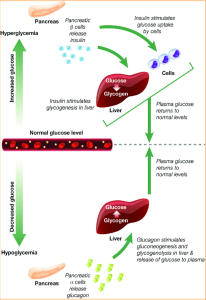
- The guidelines provide details on diet and exercise, insulin monitoring, and prevention and treatment of complications such as retinopathy, kidney disease, and nerve disease.
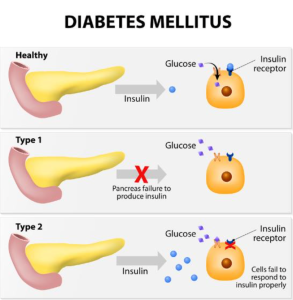
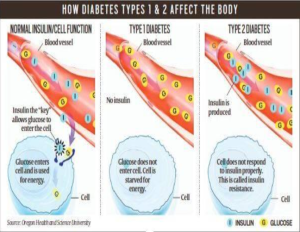
- A similar guidebook for type 2 diabetes already exists.
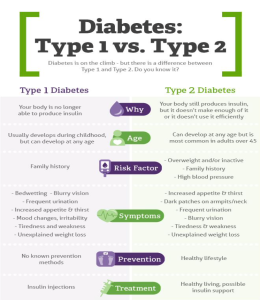
➡️UPSC 2023 General Studies Course: https://sleepyclasses.com/general-studies-for-upsc/
➡️Sociology Optional for UPSC : https://sleepyclasses.com/sociology-for-upsc/
➡️Political Science and IR for UPSC: https://sleepyclasses.com/psir-for-upsc/
➡️Signup here – https://sleepyclasses.com/
Have any query related to UPSC preparation: 📞Contact Us ► Toll-Free: 1800 890 3043 ► Mobile: 6280133177 ► Email: Sleepy.Classes@gmail.com ► WhatsApp: 6280133177



